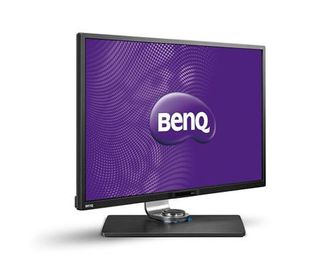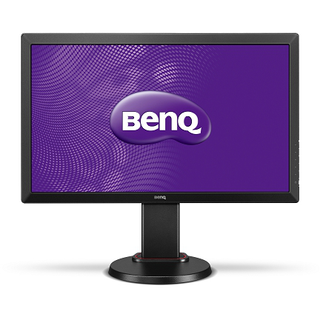BenQ BL3200PT Review: A 32-Inch AMVA Monitor At 2560x1440
The extra pixel density of a 27-inch monitor sporting a native 2560x1440 resolution can make small text difficult to read. BenQ solves the problem by adding five extra inches to its BL3200PT. Today we test this jumbo 32-inch AMVA-based panel in our lab.

A 32-Inch QHD AMVA Monitor

Although we’ve reviewed a fair number of gaming-oriented monitors lately, the bulk of our coverage over the past 18 months revolved around 27-inch QHD displays. They represent the majority of new introductions from all major manufacturers, and even some lesser-known ones. Thanks largely to panel parts from LG Display, the 27-inch IPS monitor with QHD resolution is fast becoming a popular choice for those looking to upgrade from their 24-inch FHD screens. Even though prices are still stuck around the $600 mark, there is no question that enthusiasts are buying them.
The only complaint we’ve registered along the way involves font size. With a pixel density of 109 ppi, text in most Windows applications becomes pretty small. And the older the user, the more difficult it becomes to read at normal viewing distances. BenQ now offers a neat and obvious solution to the problem. If Windows' scaling doesn’t satisfy you, then simply increase the screen size. Today we’re looking at the brand-new BL3200PT, a 32-inch monitor with a 16:9 aspect ratio and a density of 92 pixels per inch.
| Brand | BenQ |
|---|---|
| Model | BL3200PT |
| Street Price | $800 |
| Panel Type | AMVA |
| Backlight | W-LED, edge array |
| Screen Size | 32-inch |
| Max Resolution | 2560x1440 |
| Max Refresh Rate | 60 Hz |
| Aspect Ratio | 16:9 |
| Native Color Depth | 10-bit |
| Native Gamut | sRGB |
| Response Time (GTG) | 4 ms |
| Brightness | 300 cd/m2 |
| Speakers | 2 x 5 W |
| VGA | 1 |
| DVI | 1 |
| DisplayPort v1.2 | 1 |
| HDMI v1.4 | 1 |
| Audio In | 1 |
| Headphone | 1 |
| USB | v3.0 - 1 up, 2 downv2.0 - 2 down |
| Media Card Reader | SD |
| Panel DimensionsWxHxD w/base | 29.4 x 19.4-25.4 x 9.2 in740 x 490-640 x 232 mm |
| Panel Thickness | 2.7 in / 67 mm |
| Bezel Width | .6-.8 in / 14-20 mm |
| Weight | 28.7 lbs / 13 kg |
| Warranty | Three years |
A little over a year ago, we reviewed two screens (HP ZR30w Versus DoubleSight DS-309W, 30-inch Monitors, Tested) that offered a 16:10 aspect ratio in a 30-inch form factor. They were definitely a step in the right direction. The HP has since been discontinued, but you can still find the DoubleSight for around $1000. And no other companies have introduced similar displays since then.
We feel this represents a screen-size sweet spot. That 92 ppi number should look familiar to you because it’s the same pixel density as a 24-inch FHD screen, which is what’s sitting on a majority of desktops right now. So who wouldn’t want the same text and object size they’re accustomed to, but almost double the screen area? We’re going from 246 to 437 square inches. Now that’s significant!
Peeking under the BL3200PT’s hood, we find a new panel technology, AMVA, which stands for Advanced Multi-domain Vertical Alignment. In simple terms, we’re looking at a slightly different pixel structure than our old friends TN and IPS. Its goal is to maintain the high contrast and fast response time of TN panels, while incorporating IPS’ superior off-axis performance. Early examples had their share of color shift issues, but the latest generation proves to be a huge step forward.
The BL3200PT employs a panel from AU Optronics that is the first of its type we’ve seen in a mainstream product. The backlight is W-LED, which currently limits it to an sRGB color gamut. That backlight, by the way, does not use pulse-width modulation like a majority of today's monitors. It’s part of BenQ’s Zero Flicker initiative, dedicated to reducing eye fatigue. We saw the same thing on the XL2720Z and RL2460HT. Monitors using PWM don’t necessarily have visible flicker, but after a few hours of use, some folks report discomfort. By controlling brightness at the pixel level and running the backlight with constant current, that source of potential eyestrain is eliminated.
Of particular interest is the panel’s native 10-bit color depth. This monitor does not incorporate frame rate conversion and can accept a 10-bit signal through its DisplayPort and DVI inputs. Of course, to take full advantage, you’ll need a 10-bit-capable graphics board and content encoded with the extra color information.
Stay on the Cutting Edge
Join the experts who read Tom's Hardware for the inside track on enthusiast PC tech news — and have for over 25 years. We'll send breaking news and in-depth reviews of CPUs, GPUs, AI, maker hardware and more straight to your inbox.
Needless to say, the BL3200PT makes quite a physical statement even before you turn it on. Does its performance live up to the promise? Let’s take a look.
Current page: A 32-Inch QHD AMVA Monitor
Next Page Packaging, Physical Layout and Accessories
Christian Eberle is a Contributing Editor for Tom's Hardware US. He's a veteran reviewer of A/V equipment, specializing in monitors. Christian began his obsession with tech when he built his first PC in 1991, a 286 running DOS 3.0 at a blazing 12MHz. In 2006, he undertook training from the Imaging Science Foundation in video calibration and testing and thus started a passion for precise imaging that persists to this day. He is also a professional musician with a degree from the New England Conservatory as a classical bassoonist which he used to good effect as a performer with the West Point Army Band from 1987 to 2013. He enjoys watching movies and listening to high-end audio in his custom-built home theater and can be seen riding trails near his home on a race-ready ICE VTX recumbent trike. Christian enjoys the endless summer in Florida where he lives with his wife and Chihuahua and plays with orchestras around the state.
-
npyrhone "Remember that 92 ppi number we mentioned at the beginning of today's story? That seems to be a sweet spot. It works fine at 24 inches if your screen is FHD. You won’t discern individual pixels, but you’ll be quickly wishing for more screen real estate. Moving up to 2560x1440 at 27 inches increases density to 109 ppi. That’s great for gaming and photo work. However, text and small objects become difficult to see for many users."Reply
I can't understand why I would need a monitor with lower pixel density? Why not just zoom the text a notch in your word processor or whatever software you are using? Of two otherwise similar monitors I would always choose the one with higher PPI, even if I used it only for word processing. -
kid-mid I rather have the 27" QNIX Evo II 1440p for $300 or the ROG Swift for $600.Reply
The days of 60Hz are almost over with.. -
moogleslam ReplyI rather have the 27" QNIX Evo II 1440p for $300 or the ROG Swift for $600.
Except that the Swift cost $800
The days of 60Hz are almost over with.. -
Merry_Blind "The only complaint we’ve registered along the way involves font size. With a pixel density of 109 ppi, text in most Windows applications becomes pretty small."Reply
That's why I don't understand people saying 1080p is crap and has to go away. I've always find that even at 1080p, the fonts are really small, and icons and interfaces in general are very tiny. In my case, it's not even a case of not being able to read, it's just that everything looks so out of place and hideous, like, Windows wasn't meant for such resolutions.
I can't imagine 1440p. Must be ridiculous to look at. It's just aesthetically not nice.
Bring on the downvotes... -
animalosity Why in God's green earth would you pay $1000 for a 1440p display at 60hz when you can get a 4K for way less than that now. Rather have UHD....Reply -
Bondfc11 I agree with npyrhone - there are ways to enlarge everything on your screen if the density is too low. Having said that - this is an interesting panel. However, I cannot wait for the days when not TNs, but also IPS and VA panels (in large formats) become standard at 120Hz. The hertz do make a noticeable difference in everything you do on the screen.Reply -
ohim I`ll wait to see what Active Sync monitors will be able to do , an IPS with Active sync over a TN with 144hz.Reply -
Merry_Blind ReplyI`ll wait to see what Active Sync monitors will be able to do , an IPS with Active sync over a TN with 144hz.
What is Active Sync? -
Merry_Blind ReplyWhy in God's green earth would you pay $1000 for a 1440p display at 60hz when you can get a 4K for way less than that now. Rather have UHD....
It's not 1000$ though...
Most Popular




